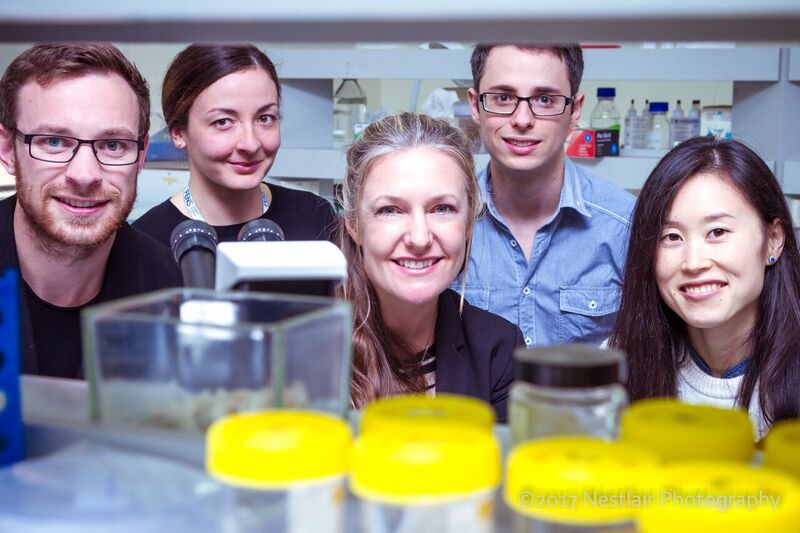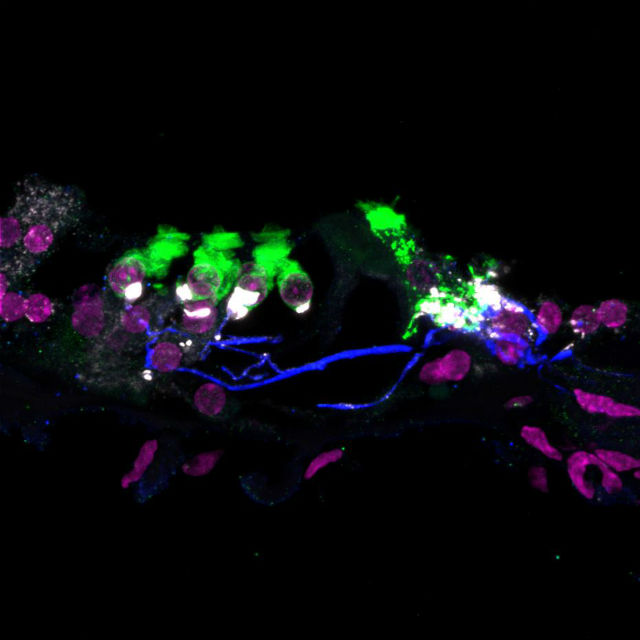Auditory Neuroscience Unit
-
Senior Research Fellow, Senior Lecturer

Dr Bryony Nayagam90354396
Research Overview
Hearing loss is a major international health problem which currently affects an estimated 360 million people (World Health Organisation, 2013) and at least one in six Australians (predicted to rise to 1 in 4 Australians by 2050). The annual economic cost resulting from hearing loss is 1.2 billion in Australia alone. Hearing loss is irreversible and results primarily from the damage to the cochlear sensory hair cells and/or auditory neurons. Whilst cochlear hair cell loss can be partially overcome by a cochlear implant, there is no routine treatment for cochlear neural loss.
- Basic neuroscience: using in vitro models to differentiate cells towards auditory phenotypes of interest (including cochlear hair cells and neurons)
- Pre-clinical studies: transplanting new (stem cell-derived) neurons into the deaf cochlea to rewire the lost circuitry (both with and without electrical
- Clinical: using advanced MRI to visualise and quantify the major structural pathways in the human auditory brainstem and the effect of disease on their integrity.
Research projects are not prescriptive and intended to give a high level overview of the main areas of current interest. Students are therefore encouraged to contact Dr Nayagam to discuss potential future projects.

Staff
- Ms Tomoko Hyakumura (post-doctoral research fellow)
- Ms Brianna Flynn (research assistant)
- Ms Madeline Nicholson (research asssitant)
Students
- Ms Jackie Ogier (PhD student, MCRI: Mechanisms of hair cell apoptosis)
- Ms Christiana Mattei (PhD student, Centr for Neural Engineering: Using organoids to study inner ear phenotypes)
- Mr Julien Zanin (PhD student, Imaging the Auditory Branistem Using MRI)
- Mr Basil Rasi (MBBS research student)
- Mr Matthew Wilson (Masters of Audiology student)
- Mr Marcus Zavou (Masters of Audiology student)
Collaborators
- A/Prof Mirella Dottori, Centre for Neural Engineering
- A/Prof Alice Pebay, Centre for Eye Research Australia
- Dr Rebecca Lim, University of Newcastle
- Dr Rachel Burt MCRI
- A/Prof Gary Rance, University of Melbourne
- A/Prof Alan Connelly, Melbourne Brain Centre, Florey Neuroscience Institute
- A/Prof Alex Hewitt University of Tasmania
- Prof Rob Shepherd, Bionics Institute
- Prof Albert Edge, Eaton-Peabody Laboratory, Harvard
- Professor David Ryugo, Garvan Institue, Sydney
- A/Prof James Fallon, Bionics Institute
Funding
- Garnett Passe & Rodney Williams Memorial Foundation
- The National Health and Medical Research Council
Research Publications
Gill KP, Hung SS, Sharov A, Lo CY, Needham K, Lidgerwood GE, Jackson S, Crombie DE, Nayagam BA, Cook AL, Hewitt AW, Pébay A, Wong RC. (2016) Enriched retinal ganglion cells derived from human embryonic stem cells. Scientific Reports Aug 10;6:30552. doi: 10.1038/srep30552
Gunewardene, N., Crombie, D., Dottori, M. and Nayagam, B.A. (2016). Innervation of developing mammalian hair cells by iPSC-derived auditory-like neurons. Stem Cells International 2016:1781202. doi: 10.1155/2016/1781202
Atkinson, P.J., Wise, A.K., Flynn, B.O., Nayagam, B.A., and Richardson, R.T. (2014) Hair cell regeneration after ATOH1 gene therapy in the cochlea of profoundly deaf adult guinea pigs. PLOS One 9(7) e:102077, doi: 10.1371/journal.pone.0102077
Gunewardene, N., Van Bergen, N., Crombie, D., Needham, K., Dottori, M. and Nayagam, B.A. (2014). Directing human induced pluripotent stem cells into a neurosensory lineage for auditory neuron replacement. BioResearch Open Access 3(4):162-175
Atkinson, P.J., Wise, A.K., Flynn, B.O., Nayagam, B.A., and Richardson, R.T. (2014) Viability of Long-Term Gene Therapy in the Cochlea. Scientific Reports (accepted 02/04/2014: doi: 10.1038/srep04733
Nayagam, B. A.(CA), Edge, A.S., Needham, K., Leung, J., Nayagam, D.A.X., Dottori, M. (2013) An in vitro model of developmental synaptogenesis using cocultures of stem cells and cochlear explants. Stem Cells and Development, 22:901-912
For a list of all recent papers (last 5 years) please visit: https://www.ncbi.nlm.nih.gov/pubmed/?term=nayagam+ba
For a list of all older papers visit: https://www.ncbi.nlm.nih.gov/pubmed/?term=coleman+b+and+shepherd+r
Research Projects
- Directed Differentiation of stem cells to cochlear phenotypes
- Disease modelling
- Application of stem cell-derived neurons to the deaf cochlea
- Using MRI to examine the human auditory brainstem
Faculty Research Themes
School Research Themes
Key Contact
For further information about this research, please contact Senior Research Fellow, Senior Lecturer Dr Bryony Nayagam
Department / Centre
Audiology and Speech Pathology
Unit / Centre
MDHS Research library
Explore by researcher, school, project or topic.
